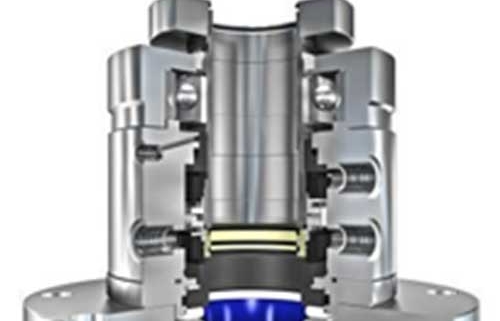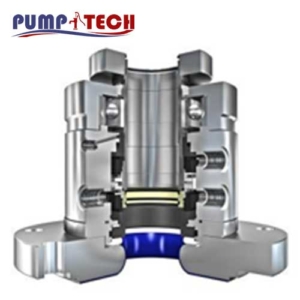
Vessel and Agitator Seals | Mixer and Agitator Cartridge Seal to Vessel Seal Standard DIN 28138 for Glass-lined Chemical Reaction Vessel — with Integrated Bearing

Features mechanical seal type ck736
- California Residents: PROPOSITION 65 WARNING
- Dual-cartridge seal with integrated radial bearing to DIN 28138 for glass-lined vessels.
- Fits mounting flange to DIN 28137-2 and shaft ending to DIN28159.
- Back-to-back seal arrangement with unbalanced faces.
- Reversed pressure capabilities inboard.
- Liquid-lubricated (CK 736) or dry-running (CK 736D) face versions available.
- Non-standard sizes, special designs and material options are available on request.
- Suitable for application in explosive areas. Certificates of conformity according to European Directive 94/9/EC (ATEX) Cat. 1, 2, or 3 on request.
About Mechanical seal type ck736
The Type CK 736 is a dual-pressurized, liquid-lubricated cartridge seal for glass-lined mixing and agitating equipment with top-entry agitator shaft. An integrated radial bearing secures an optimal shaft alignment and proper seal operation. A value-engineered design, high level of standardization and broad material options make this seal a cost-efficient solution for general-duty applications in the chemical and pharmaceutical industry. Standard versions are compliant with vessel seal standard DIN 28138 Parts 2 and 3. They are designed for use on steel-made agitated chemical reaction vessels to DIN 28136, to fit on a mounting flange to DIN 28137-2 and agitator shaft end dimensions to DIN 28159. Hardware adaptations to fit to non-DIN equipment are available on request.
By exchanging the seal faces, a CK 736 wet seal can easily be converted to a contacting, dry-running seal. Type name then changes to CK 736D. Advantages of contacting dry-running seals include freedom from contamination by barrier liquid and a low face wear rate, together with a cost-efficient, easy-to-install (gas) supply system. To simplify inventory, seal components are standardized with the other seal types of this family CK 725(D) and CK 726(D).
The seal is suitable for operation in potentially explosive atmospheres. Depending on individual explosion protection requirements, the seal operating limits may differ from the values given in the parameters section. Furthermore, additional monitoring devices may be required.
Design Features mechanical seal type ck736
- Dual cartridge seal to DIN 28138 for glass lined vessels
- Fits mounting flange to DIN 28137-2 and shaft end dimensions to DIN 28159
- Back-to-back seal arrangement with unbalanced faces
- Liquid lubricated or dry running (D) versions available
- Reverse pressure capabilities inboard
- Integrated radial bearing for optimal running precision
- Product wetted components made of non metal materials
- Special designs and material options available on request
- Cooling flange or cooling jacket available on request
- Limits of seal operation without barrier pressure available on request
- Suitable for application in explosive areas. Certificates of – conformity according to European Directive 94/9/EC (ATEX) Cat.
Recommended Applications type ck736
- Mixer and agitators
- Other rotating equipment
Operating range mechanical seal type ck736
| Temperature Limits | -40°F to 392°F/-40°C to 200°C |
|---|---|
| Pressure Limits | Vacuum to 16 bar(g) Dry-running variant up to 6 bar(g) |
| Speed Limits | 400fpm/2m/s Dry-running variant: 300fpm/1.5m/s |
| Size Limits | 40mm to 125mm |
Product Description type ck736
Type CK736 vessel and agitator seals are factory-tested dual cartridge seals with an integrated radial bearing, compliant with vessel seal standard DIN 28138 Parts 2 and 3. They are designed for use on glass lined agitator vessels to DIN 28136, to fit on a mounting flange to DIN 28137-2 and agitator shaft end dimensions to DIN 28159. All product wetted parts are non metal materials.
Both liquid lubricated and dry running versions are available.
All versions are suitable for operation in potentially explosive atmospheres. Depending on individual explosion protection requirements, the seal operating limits may differ from the values given in this data sheet. Consult John Crane for more information.



